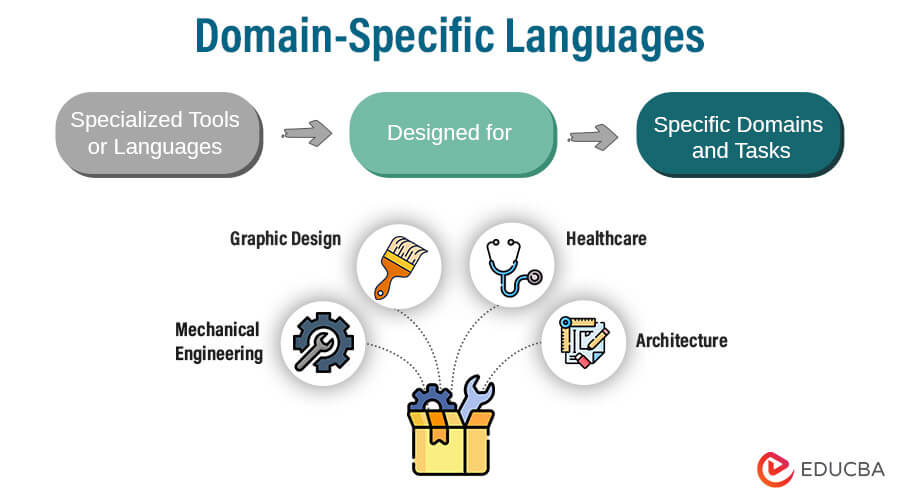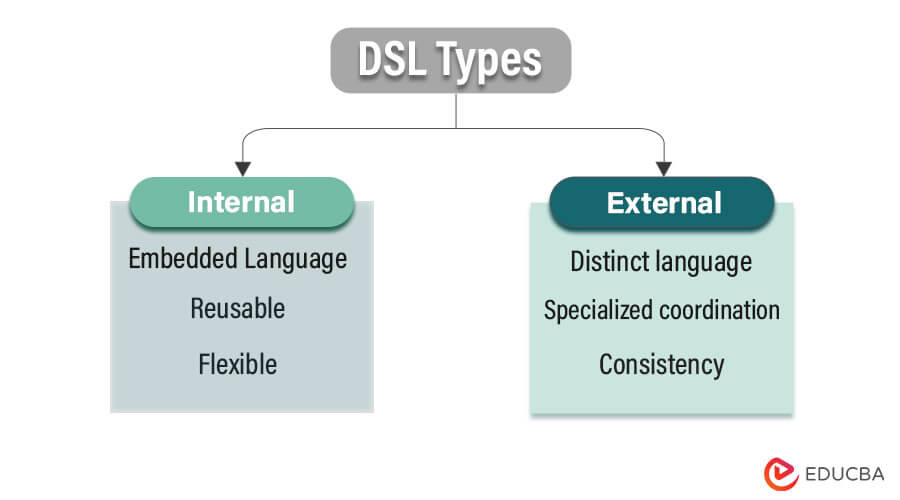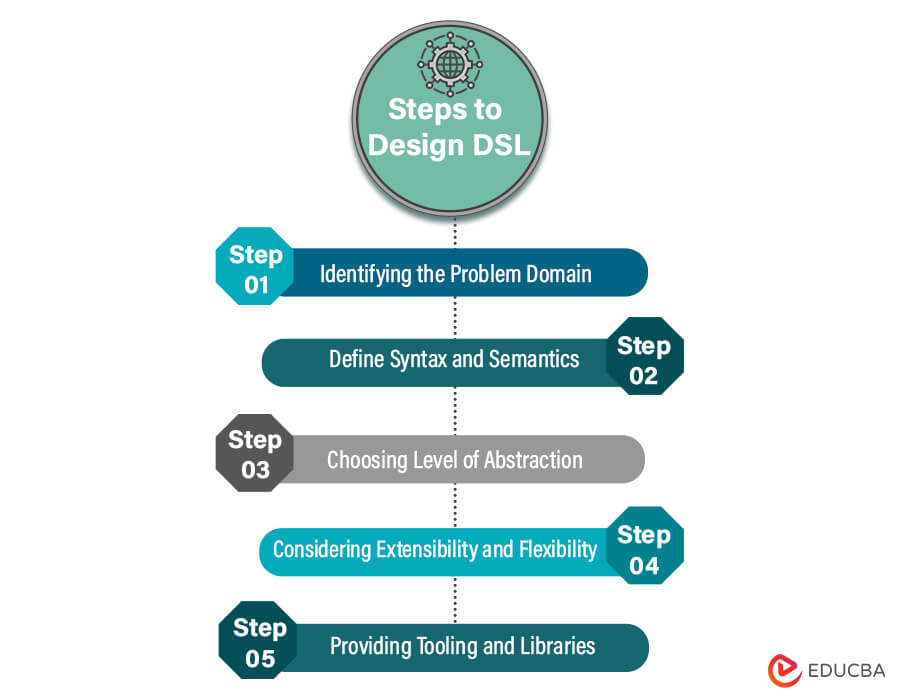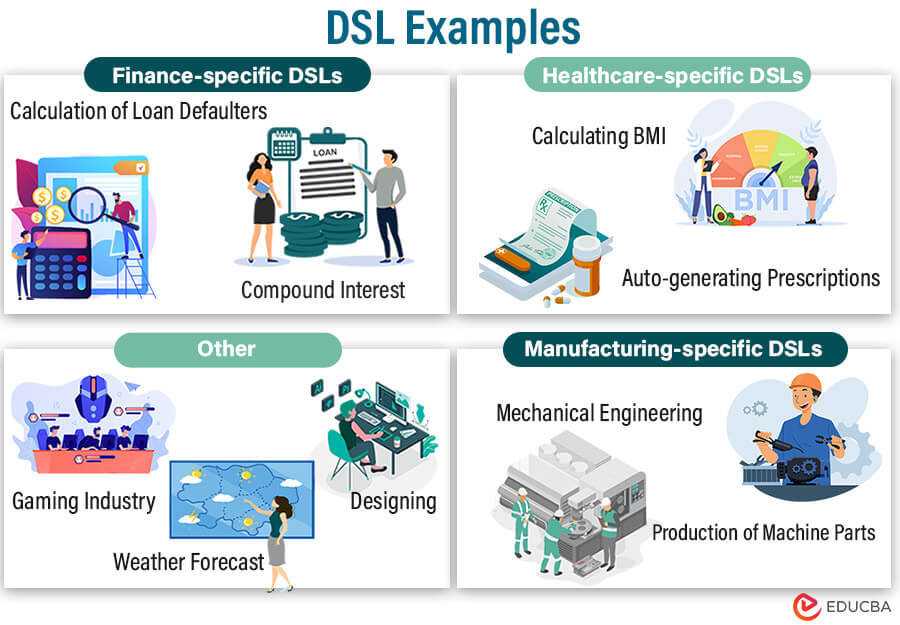Updated October 17, 2023
What is Domain-Specific Languages
A Domain-Specific Language (DSL) is a specialized language focusing on a limited, specific set of tasks within a particular problem domain. DSLs are created to provide a more efficient, concise, and expressive means of solving problems within that domain. These languages use domain-specific terminology, notation, and constructs to make it easier for domain experts to communicate their requirements and solutions to software developers.
Table of Contents
- What is Domain-Specific Languages
- Purpose and Benefits
- Comparison
- DSL Types
- Designing a DSL
- Syntax and Semantics of DSLs
- Implementing a DSL
- DSL Examples
- DSL Adoption and Considerations
Purpose and Benefits of using DSLs
- Efficiency: DSLs streamline development by eliminating the need to navigate through irrelevant language features. This results in shorter development cycles and more concise code.
- Improved Communication: DSLs bridge the gap between domain experts and software developers. They enable domain experts to express their requirements directly, reducing misunderstandings and communication issues.
- Enhanced Productivity: DSLs allow for rapid development and maintenance of software within a specific domain, as developers can work with abstractions tailored to that domain.
- Error Reduction: By enforcing domain-specific rules and constraints, DSLs can reduce errors and ensure that the software adheres to the expected behavior within the domain.
- Increased Reusability: DSL components and libraries can be reused across projects within the same domain, further accelerating development and maintaining consistency.
Comparison with General-Purpose Programming Languages
| Aspect | DSLs | General-Purpose Languages |
| Scope and Purpose | Narrow and domain-specific | Versatile and broadly applicable |
| Abstraction Level | High-level, domain-specific | Lower-level, versatile |
| Expressiveness | Highly expressive within the domain | May require more code for domains |
| Ease of Use | User-friendly for domain experts | Potentially steeper learning curve |
| Integration | Tightly integrated with specific domains | Versatile but may need adaptation |
| Error Minimization | Enforces domain-specific constraints | Errors due to domain mismatch |
| Development Time | Reduces development time in the domain | May require more code and time |
| Reusability | Components can be reused in the same domain | General-purpose libraries available |
| Maintenance | Easier maintenance within the domain | Complex maintenance as codebase grows |
DSL Types
Below are different types of Domain-specific languages
1. Internal Domain-specific language
Internal Domain-specific languages are implemented within a general-purpose language allowing the use of the existing syntax of the host language. It uses the compiler and interpreter of its main language, which eases out the programming process as compared to external DSL. Internal Domain Specific Languages are Python, JavaScript, C++, and other general-purpose languages.
Characteristics
- Embedded language: Internal DSLs are implemented within a general-purpose programming language, and they use base language syntax and competencies to target a specific domain problem.
- Reusability: Existing knowledge and syntax are used from its base language to create domain-specific language.
- Flexibility: GPL and DSL are well balanced in internal DSLs as they provide flexibility to use the host language’s regular syntax, which requires less development tools and efforts as compared to external DSLs.
- Challenges: Internal DSLs are possibly less optimized than external DSLs for specialized tasks as they are limited to the structure of their base code.
Example use cases
Let us take an example of ruby on Rails for controlling and mapping the URL routes of a web page with a home page having login information, about us, and contact us pages:
Naming route:
root 'page#login'Here we are defining the controller and index of our webpage which is the login page.
Define routes:
get '/contact' , to: 'page#contact' , as: 'contact_us'Here we are defining the specific URL route of the Contact Us page
DSL allows us to display and manage routes in a web application, it deals with complex URL routing and provides easy handling and security.
Advantages
- Benefits the developers as they are familiar with the same language and have no need to learn the new language’s syntax
- Reuse of existing libraries and tools from the base language helps in reducing the time requirement
- Use of a wide range of libraries for writing internal DSLs
Disadvantages
- Internal DSLs are Constrained by the syntax of its host language
- Making chaos by mixing Domain-specific language with general-purpose language.
- Any modification in the project may affect the performance of internal DSL.
2. External Domain-specific languages
In external DSL, a separate scripting code is engineered for a particular field, and this code is processed in another host language. Here, different languages are used for designing DSL and for the DSL execution process. For Example SQL for querying tables in database and HTML, CSS for website designing.
Characteristics
- Distinct language: the DSL and host languages used for specific tasks are separate from each other with their own syntax, semantics, and development tools.
- Specialization: External DSLs are specialized in coordination with a particular problem domain resulting in efficient solutions for specific domain problems.
- Consistency: As a result of isolation from the host language external DSLs provide data safety and increase accuracy.
- Challenges: DSL has a learning curve as it possesses challenges for learning new languages and their syntax which may require additional time and effort.
Example use cases
Let us take an example of SQL which is an external DSL used for performing different operations on a Student table from a database.
Select the Student table from the database:
Select * From StudentInserting student data:
INSERT INTO Student (name, unique_id)
VALUES('Soren' , 231);Validating Data for unique student ID
ALTER TABLE Student
ADD CONSTRAINT Unique_Student_id UNIQUE(unique_id)DSL provides us with different features for inserting, updating, querying, and validating our data, DSL gives us many other operations to perform on our data hence maintaining data efficiency and integrity.
Advantages
- Specialized code results in resourceful and communicative solutions to targeted problem
- Language separation yields a lower error rate
- External DSLs have their development tools, compiler, and IDE support.
Disadvantages
- Merging different languages decreases the accuracy
- DSL for one project cannot be used in any other program hence limiting code flexibility.
- The overhead cost of maintaining external DSLs and development tools.
Designing a DSL
Below are steps for designing a DSL
1. Identifying the problem domain
The very first step in designing a DSL is identifying the core of the problem domain, which comprises the specific area of the problem, which may come under different approaches such as textual or graphical DSL or projectional editor. Let us take an example of developing a DSL for mathematical calculation using Xtext so the base role is mathematics and we will be dealing with arithmetic operators.
2. Defining the syntax and semantics
It is important to understand the rules and regulations of the programming code and we need to understand their meaning before the execution process. Here, the rules define the structure of our arithmetic operation and the semantics define the performance method of our operators
3. Choosing the appropriate level of abstraction
Simplify our coding level, which may help users to better understand the coding flow by choosing an appropriate level of abstraction. Code allows users to perform basic operations by providing a higher level of abstraction and simplifying the complex implementation.
4. Considering extensibility and flexibility
Generating extensible code that can be enhanced according to the user’s need without changing its definition and adopting new features. Users can reuse variables and create complex expressions.
5. Providing tooling and libraries
For the smooth working of a DSL code, its tools and libraries are required, which include specific IDEs, parsers, interpreters, and code editor
Syntax and Semantics of DSLs
DSL syntax and semantics are essential parts of their design and functionality.
Syntax elements and conventions
Syntax – every code written has a proper format and structure. Similarly, DSL should be written in a properly structured manner such that it should fulfill the needs of the domain, the hierarchy of the statement, the punctuation all these matters. If we write a DSL code for the finance department, we should keep in mind how the constants will be defined to save the results. If we write a DSL for the 3D geometric model, we need to define the shapes and dimensions of the models properly.
Conventions can be defined, what type of variables we use, how we define the styles, and other guidelines for proper approach.
Expressiveness and readability
Expressiveness – while coding a DSL, it should be kept in mind how well DSL will handle different scenarios of a specific domain.
Readability – users of DSL may be familiar with coding or maybe not. So DSL should be written in such a way that all users of a particular sector can use it effectively without facing any issue. A small tutorial and a handy document should be enough to understand the usage of DSL. While defining, make use of such constants that are relatable to the domain and easy to understand. For example, in the finance industry, making use of context like ‘calculate simple interest” will make users understand that the code here is written for calculating simple interest,
Domain-specific operations and constructs
Users of a specific model have a particular mindset of their domain. So if DSL is built using the same mindset, it becomes easier for the users to understand the DSL model and execute it to get the best results. For this, collaboration with the users is a must. While developing DSL, get the complete idea from the users, how they think about their domain. How workflows in their domain.
Semantic analysis and interpretation
When DSL is developed, it is necessary to check whether all the coding standards are followed. All the coding is done according to the needs of the domain and the users.
Interpretation, in simple words, is giving the command to the system to perform actions according to the code written in DSL. To do this, code should be understandable to computer systems.
Implementing a DSL
Here’s a general overview of implementing DSL
DSL implementation approaches and techniques
External DSL
- Definition: External DSLs have their own dedicated syntax and semantics. Developers usually create them using language workbenches, parser generators, or manually develop parsers.
- Techniques: You can use tools like ANTLR, YACC, or parser combinators to generate parsers and lexers for the DSL. Language workbenches like Xtext and Spoofax provide frameworks for creating external DSLs.
Internal DSL (Embedded DSL)
- Definition: Internal DSLs embed themselves within a general-purpose programming language, leveraging the language’s syntax. They provide domain-specific constructs, often through libraries and frameworks.
- Techniques: Develop DSLs as libraries in a general-purpose language. For example, you can create internal DSLs in Ruby, Python, or Groovy, using their native language features to provide domain-specific constructs.
Hybrid Approach
- Definition: A combination of internal and external DSLs. It allows you to take advantage of the expressiveness of internal DSLs and the independence of external DSLs.
- Techniques: Develop core DSL constructs as an internal DSL for ease of use and develop more complex or extensible features as an external DSL with its dedicated syntax.
Language parsers and compilers
Parsers are generally used with external DSL. In simple words, the parse breaks down a DSL code, analyses it, and structures it in such a way that it becomes easy for the system to execute.
Here’s a mathematical expression: 5 + 6 * 7.
When the parser comes into play, it will break down the expression into small bits: 5, 6, 7, +,*.
Now, it takes into account its sequence and hierarchy, giving priority to multiplication first, followed by addition. This approach solves mathematical expressions and delivers accurate results.
Compilers -Once the parser does its job of breaking down, now it’s time to execute. The compilers compile the code to generate accurate results i.e. 47.
Interoperability with existing systems
- Integration Layer: Develop an integration layer that facilitates communication between the DSL and existing systems. This layer can handle data exchange, function calls, or other interactions.
- APIs and Libraries: Create APIs and libraries that allow DSL code to interface with external systems and services. Ensure that these interfaces adhere to established standards.
- Data Formats: Define data formats and protocols for exchanging data between the DSL and other systems, such as XML, JSON, or custom serialization formats.
Testing and debugging strategies
- Unit Testing: Develop unit tests for individual DSL components to ensure they function as expected. Use testing frameworks and libraries suitable for the host language.
- Integration Testing: Perform integration tests to verify that the DSL integrates correctly with external systems and produces the desired results.
- Debugging Tools: Create debugging tools or leverage existing ones that support DSL development. These tools should help identify and fix issues in DSL code.
- User Testing: Involve domain experts and end-users in testing to ensure the DSL meets their requirements and expectations.
- Continuous Integration: Implement a continuous integration (CI) process to automatically build, test, and validate DSL code changes, ensuring stability.
Domain-Specific Languages Examples
Below are some common examples of DSL
1. Finance-specific DSLs
The finance sector widely uses DSL. Some of its use cases include automating the calculation of a loan defaulter list at the end of every month and calculating compound interest, among others.
Let’s understand Compound interest calculation.
Syntax:
Principal <principal>, rate <rate>, and period <period>Implementation:
Principal 5000, rate 3.5%, and period 4 years
2. Healthcare-specific DSLs
In the Health care industry, DSL has made its place in applications like calculating BMI (Body Mass Index ), specifying a diet according to patients’ reports, auto-generation of prescriptions based on patient’s health and records, etc.
Let’s ease it with BMI Calculation.
Syntax:
Weight <weight> kg and height <height> cmImplementation:
Weight 65 kg and height 175 cm.
3. Manufacturing-specific DSLs
In Mechanical and Production Engineering, engineers produce different types of machine parts. Let’s consider the production of plastic bottles. For this, we require a dye, in which plastic granules will be injected and through processing, we get our final product. CNC machines achieve specific dimensions for producing the required dye. After the production of the dye, it goes for a quality check and this quality check can be automated using DSL.
Syntax:
PartId <partid> and tolerance <tolerance>Implementation:
PartId AG213 and tolerance + 0.05 , -0.05
4. Other domain-specific examples
- Gaming industry
- Weather forecast
- Designing etc.
Domain-Specific Languages Adoption and Considerations
Here are some important considerations while implementing a DSL.
Evaluating the suitability of a DSL for a specific domain
The development of solutions for any problem depends upon understanding the problem and its needs. So before developing DSL, it is important to know whether this DSL will meet the needs of the problem. The problem may have its variations and complexities and hence the DSL should handle all of those challenges. Hence development process of a DSL needs the involvement of experts
Integration with existing systems and workflows
After the development of Domain-Specific Languages, DSL nature should be such that it should align with the existing system and workflow.
This requires a few points to be considered:
- Data should be properly exchanged between DSL and the system.
- If DSL is for the finance industry, security protocols and checkpoints should be fulfilled
Learning curve and adoption challenges
DSL sometimes can be difficult for users to execute. DSL has some graphs, charts, and curves. Understanding graphs and curves is much easier than understanding the code. Hence, users rely on learning curves, and it is necessary to provide an easy-to-understand language report or documentation after each coding development. This report explains how to execute Domain-Specific Languages. In addition, the team arranges reports, training sessions, and tutorials for a better understanding of DSL. They address use cases and benefits to improve DSL performance and execution. All these practices return better results.
Maintenance and evolution of DSLs
Maintenance of the code is as important as development of the code. There can be various bugs so, solving the bugs is an important part of DSL. Developers often introduce such bugs by not adhering to standard coding formats and practices, and by not covering all use cases during development and testing. Adding new features is also a part of maintenance. Sometimes DSL works and returns proper results with a small amount of data. But when the data is large, there are possibilities of getting bugs.
Conclusion – Domain-Specific Languages
Domain-Specific Languages is part of the program language, but it has developed in such a way that it will work for a specific domain only. We have studied its syntax, use cases, error handling, debugging, execution, etc. Developers develop DSL for different industry variants using various approaches. We also looked at how it is user-friendly by making use of convincing context, graphs, and simple documents and tutorials. The most widely used model in a specific domain and problems provides us with consistency, integrity, efficiency, and data security.
Recommended Articles
We hope that this EDUCBA information on “Domain-Specific Languages” was beneficial to you. You can view EDUCBA’s recommended articles for more information.





